

Therefore, it could be said that the difference between the studios is the really difference between the management styles of the two key figures, Goto and Kise.įor instance, Goto is a typical morning person who arrives at the studio regularly at 10:30 am and leaves at around 10:30 p.m., whereas Kise is a night person. No specific quality of animation skill (action-oriented or heartwarming) is associated with either of the studios.

It is not as though each studio works on parts of the same project, nor is it the case where each studio works on entirely separate projects. And Kise, who joined I.G later, seemed to be the right person, so Ishikawa asked Kise to head the second studio," says Goto, one of the few people who know of the beginnings of the company. "I think it was Ishikawa's idea to have a key person in each studio and let the two studios compete. By the way, Kazuchika Kise was the key figure in Studio 2. So it was decided to split the staff into two groups: Studio 1 and Studio 2. Eventually, as the number of staff increased, there wasn't enough space in the room. When Production I.G was created, there was just one one room that was called "Animation". (The "I" is President Ishikawa's initial). As you may have thought, the letter "G" of Production I.G stands for Goto's "G", as he's been a core member of the company since its establishment. The key figure of Studio 1, then as now, is animator Takayuki Goto.

What it is now called Studio 1 used to be the one and only animation production room in the early days of Production I.G (then IG Tatsunoko). Production I.G is now a structure with nine animation studios, one background studio, one CG room, one game development section and a detached studio in Niigata.


 0 kommentar(er)
0 kommentar(er)
